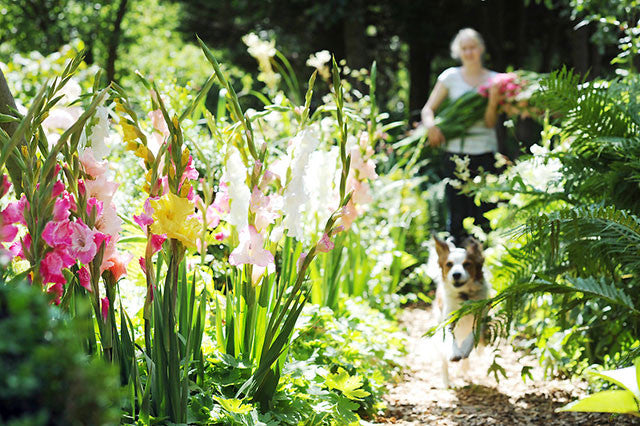
Glad to have 'em in your garden: All about Gladioli Corms
It was not all that long ago that gladioli were considered old fashioned, and something the Dame Edna would throw into her audiences – and little else. However, rather like the dahlia, in the past few years gladioli have been elevated to the hot spot. A new generation of gardeners are appreciating and valuing them for their colourful flower spikes, which are especially useful for cutting and bringing indoors, and for creating the trendy ‘tropical look’ to beds and borders.

Many allotment gardeners grow their gladioli in straight lines, for ease of cutting, and in this situation the Large-flowering (Grandiflorus) hybrids can look rigid and uninspiring. But, in the garden, if you plant a dozen or more bulbs (actually corms) in bold drifts between ornamental grasses, crocosmia and daylilies, the tall, stately flower spikes of the gladioli will look magnificent in a mid- to late summer border.
| Farmer Gracy’s Gladiolus Conundrum |
| See if you can work out the answer to this question (answer at the bottom of this page): The Latin name Gladiolus shares its origin with the Roman ‘gladiator’, famous for often mortal combat in the arenas of the Roman Empire. So, understanding this, what has become the English common name for the Gladiolus? |
| 1) Shield rose 2) Chariot grass 3) Gladiator flower 4) Sword lily |

For the best look with gladioli I would always plant many corms of the same variety, or several in flower colours that are complementary, unless you are aiming for a less formal ‘cottage garden’ look – the kind of look that I call the ‘fruit salad’ effect, with lots of colour variety. Most gladioli grow to about 1.2m tall, so they generally poke above the herbaceous plants around them, to give the border that ‘wow’ factor.

Gladioli are a favourite with flower show exhibitors and flower arrangers, which is one of the reasons why plant breeders have given us such a good choice of styles and colours.
Choice of gladiolus styles
Over the past hundred years and more, it is thought that some 10,000 Gladiolus cultivars have been bred, or species discovered. Not all of them are available commercially, of course, but it does mean that there are plenty to choose from.
Take your pick from bright colours that are guaranteed to make a statement in your garden, or the romantic pastel shades, including pinkish-grey, that can be used to subtly glam-up your garden.

Some cultivars come as bi-colours, sometimes with picotee edges, or dainty splotches on the lower petals and with contrasting stripes and throats.
If you simply want to use these slim-fit plants to make vertical flashes of colour in between large clumps of herbaceous plants, then choose the Butterfly varieties, which have smaller flowers.

If you want to grow gladioli in pots on the patio, or your garden space is limited, choose Dwarf (Gladiolus nanus) varieties, which are petite and demure, growing to a maximum height of around 60cm, so they don’t need staking or tying up.

The flowers usually bloom early; they are star-like and often with distinctive cerise markings on the petals, surrounded by fans of tall, tapering green foliage. Most are more or less weatherproof, too, and are able to cope with a British winter outdoors, so there will be no need to ‘lift’ the corms in the autumn.
When to plant gladioli
Gladiolus corms take 70 to 100 days to grow and flower, so if growing them for cuttings and bringing indoors, plant a few corms every couple of weeks from late spring to mid-July, to have flowers for cutting through summer to early autumn.
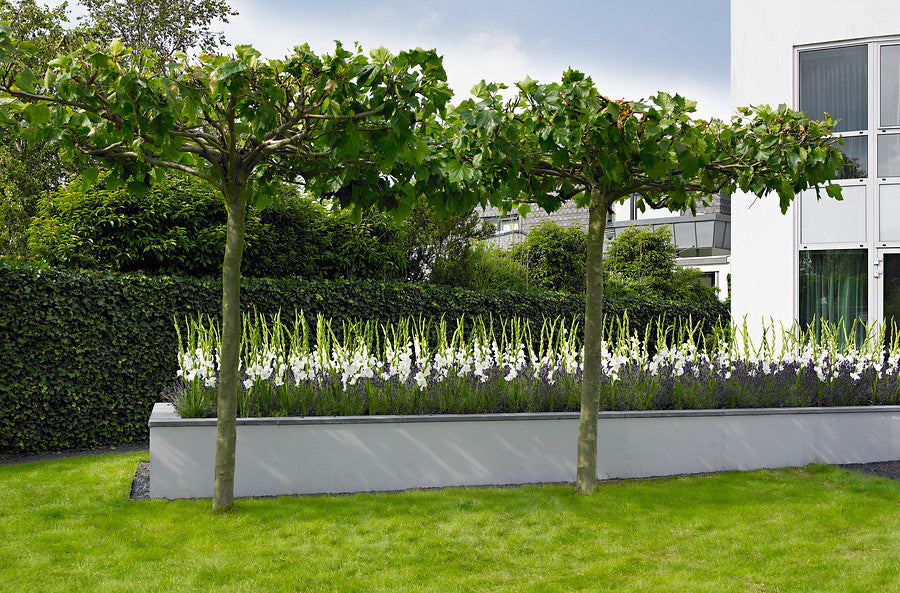
Remember that the earlier the planting, and the longer the growing season, yields the best corms for lifting and replanting the following year.
How to get early flowers
You can get flowers in late May and June, if you plant corms in single layers in deep seed trays, kept really moist, and sited in a warm propagator until roots and a few centimetres of shoots are produced. Then they can be planted outside in late February, in soil that has been warmed under frames or cloches. It is surprising how hardy the plants can prove to be once they have started into growth.

As Gladiolus blooms usually last for about three weeks, and we hope our summers will be longer than that, it’s a good idea to achieve a longer-lasting display by planting corms over several weeks.
Where to plant gladioli
Choose a position that gets a fair amount of direct sun throughout the day. Light shade in the morning or late afternoon will be OK.

Sandy, light soils are best. If you have a heavy, clay soil you can fork coarse grit into the planting area to improve drainage. Or put a layer of grit at the bottom of each planting hole. This stops water collecting around the base of the corm, which will cause it to rot.

Before planting, enrich the soil with a handful of low-nitrogen fertiliser, but be sure to mix the soil and fertiliser well so that you don’t ‘burn’ the corms.
How to plant gladioli corms

Plant the corms quite deep, and I would suggest deeper than most books tell you. I plant mine 15-20cm deep, and 15cm apart. I use a bulb planter but a long trowel will do. Secured deep in the ground, you are less likely to need a stake. Particularly on sandy soils it helps to plant them this deep, so they are well anchored against strong winds. This extra-deep planting does not seem to harm the plants or delay flowering.
On-going care of gladioli
Unless they are growing in amongst other plants, large flowered varieties need individually staking with short canes around 30cm tall.
Keep plants well-watered, throughout the summer but especially early on when the foliage is emerging, as plants tend to be very thirsty at this stage. If we get prolonged dry weather, mulch the soil around the plants to keep it moist.

The flowers open from the bottom of the stem upwards. As soon as the flowers appear, feed them with a high potash liquid tomato feed every two weeks until they start to fade. Remove individual blooms as they fade.
Cutting gladioli for the vase

Choose a spike with just the lowest or first bud opening or in bloom. Other buds must be showing colour if they are to open after picking. Cut the stem as low down as possible, with a pair of secateurs or a sharp knife, but keep as many leaves on the plant as possible, and at least four complete ones.

Should I lift the gladioli corms in autumn?
Most gladiolus are not completely hardy but, if you have a sandy soil, live in a sheltered garden, in the south of Britain, and the corms are planted deeply enough – and you give them a good thick winter mulch of well-rotted compost, they’ll probably survive.
However, be aware that corms overwintered outside under mulch may still perish in a really severe or prolonged winter, and, if they do survive, they will probably come in to growth and flower a little later than those lifted, stored and replanted in spring.

If you do leave your corms in the soil every year, it is a good idea to dig and divide the clumps every three or four years to select the best corms for replanting. Without this, the new cormlets that form on the sides of the gladiolus corms will cause congestion, and the available soil nutrients will have to be shared. The result of this is that you will end up with masses leaf and no flower.
How to lift and store gladiolus corms
Further north, or in cold areas, lift the corms in autumn once the leaves begin to turn yellow. Trim back the leaves to within a few centimetres of the corms, dust with sulphur, then leave to dry for a few weeks. Then brush off the soil and store the corms in mesh bags in a dry, dark frost-free place. Don’t keep the leaves on or hang up bunches to dry, as any remaining damp can cause rots later on in storage.
The problem of thrips
While generally pest- and disease-free, gladioli can be attacked by thrips, also known as thunder bugs. These tiny insects suck the juicy sap from the plant, leaving a silvery appearance, eventually causing the plant to turn brown. Thrips also cause deformed flowers and prevent flower spikes from opening.
When storing the corms from affected plants, cut down and dispose of the top growth (preferably by burning or sending to your local authority green waste centre). The important thing is to destroy and expel it from being anywhere near your corms. Do this before the corms are fully dried, to reduce the number of overwintering thrips, and so reduce the likelihood of infestation next year.
Organic pesticides (based on plant oils and extracts or fatty acids) with contact action may give some control. They include Doff Greenfly and Blackfly Killer and Bayer Bug Free. Chemical systemic sprays, such as Bug Clear Ultra, while not being so good for the environment, are absorbed into the plant tissue so may give better control. Importantly, plants in flower should not be sprayed during the daytime due to the danger to pollinating insects.
Gladiolus Varieties
Farmer Gracy has selected 34 of the very best cultivars to offer its customers, as well as three mixed collections, so you are spoilt for choice. If I had to choose just a small selection for my garden they would be the following.
Of the Large-flowering (Grandiflorus) types, most years I grow– 'Espresso', whose buds really are jet black, in pure silk velvet, opening to a deep burgundy-red.

From left to right: Gladiolus Espresso, Gladiolus Evergreen, Gladiolus Shaka Zulu, Gladiolus Purple Flora
For something a bit different, look out for the fresh green varieties such as 'Evergreen'. It produces showy, upright spikes of flowers. These are particularly useful for giving garden borders a contemporary look. Half a dozen or so look stunning in a simple white vase or tall glass.
Partner these lime green blooms with other gladiolus varieties with dark velvet-textured flowers. Choose from varieties such as 'Espresso', or the deep maroon 'Shaka Zulu', or the purple 'Purple Flora'.
The last one, 'Purple Flora', is arguably my all-time favourite cultivar. The buds start as indigo blue, and open out into different shades of purple depending on the light. There are other purples, but they mostly have white petal markings and as the flowers age these becomes more prominent, and dilutes the beauty and richness of the overall spike. You don't get this problem with 'Purple Flora'. This variety also grows a little taller than most at 1.5m.

From left to right: Gladiolus Georgette, Gladiolus Prins Claus, Gladiolus Charm, Gladiolus Dancing Doll
Growing up to 75cm are the Butterfly varieties, so-called because when the flowers are open their petals resemble the open wings of a butterfly. My favourites among these are 'Dancing Doll' (cream-yellow and bright red) and 'Georgette' (bright yellow and orange).
Finally, the Dwarf (or Nanus) gladioli grow to just 60-70cm so they are easy to look after, and suitable for growing in patio pots. They include 'Prins Claus' (white and raspberry pink) and 'Charm' (candyfloss pink with a white throat), and they should be found a place in any garden.
The answer to the Gladiolus Conundrum: 4) Sword lily. In Latin, gladius means ‘sword’, so a ‘gladiator’ was a person armed with a sword. ‘Gladiolus’ actually means ‘a little sword’, and gets its name from its sword-shaped leaves.
 |
Graham Clarke |





























































































































































































































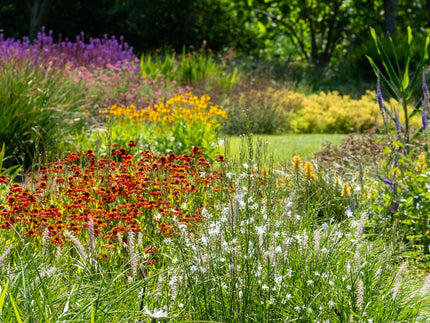
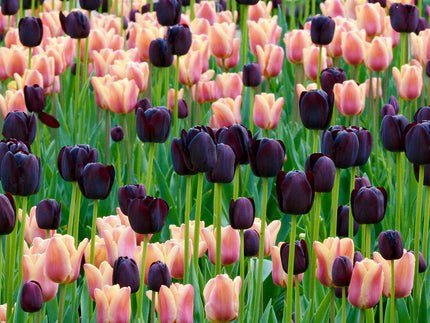
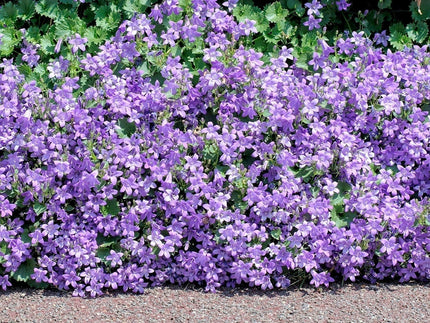

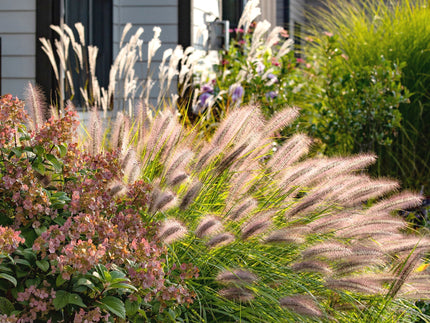
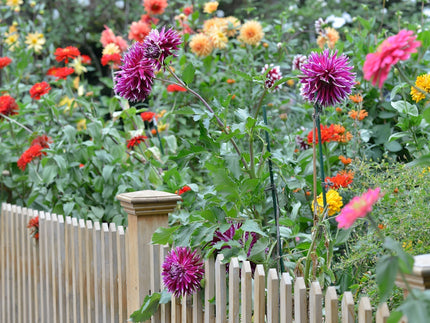
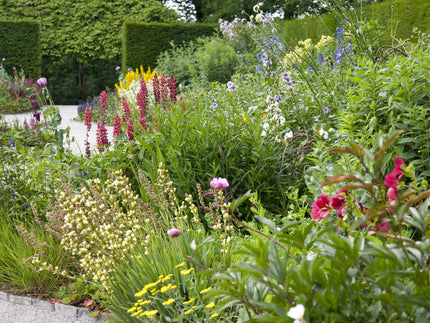
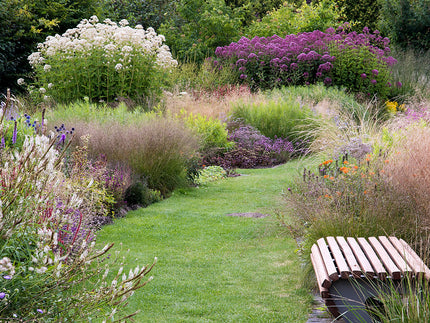
3 comments
Last year my daughter & i purchased a selection of bright coloured gladiolis from Chelsea flower show , they flowered beautifully , i dug mine up & re planted the corms , my daughter didnt
All have flowered again this year but all are white ??? Is this normal ? Thanks
That one’s called Purple Flora!
https://www.farmergracy.co.uk/collections/gladioli-corms-uk/products/gladiolus-purple-flora-corms-uk
May I know the name of the two pots of purplish gladiolus